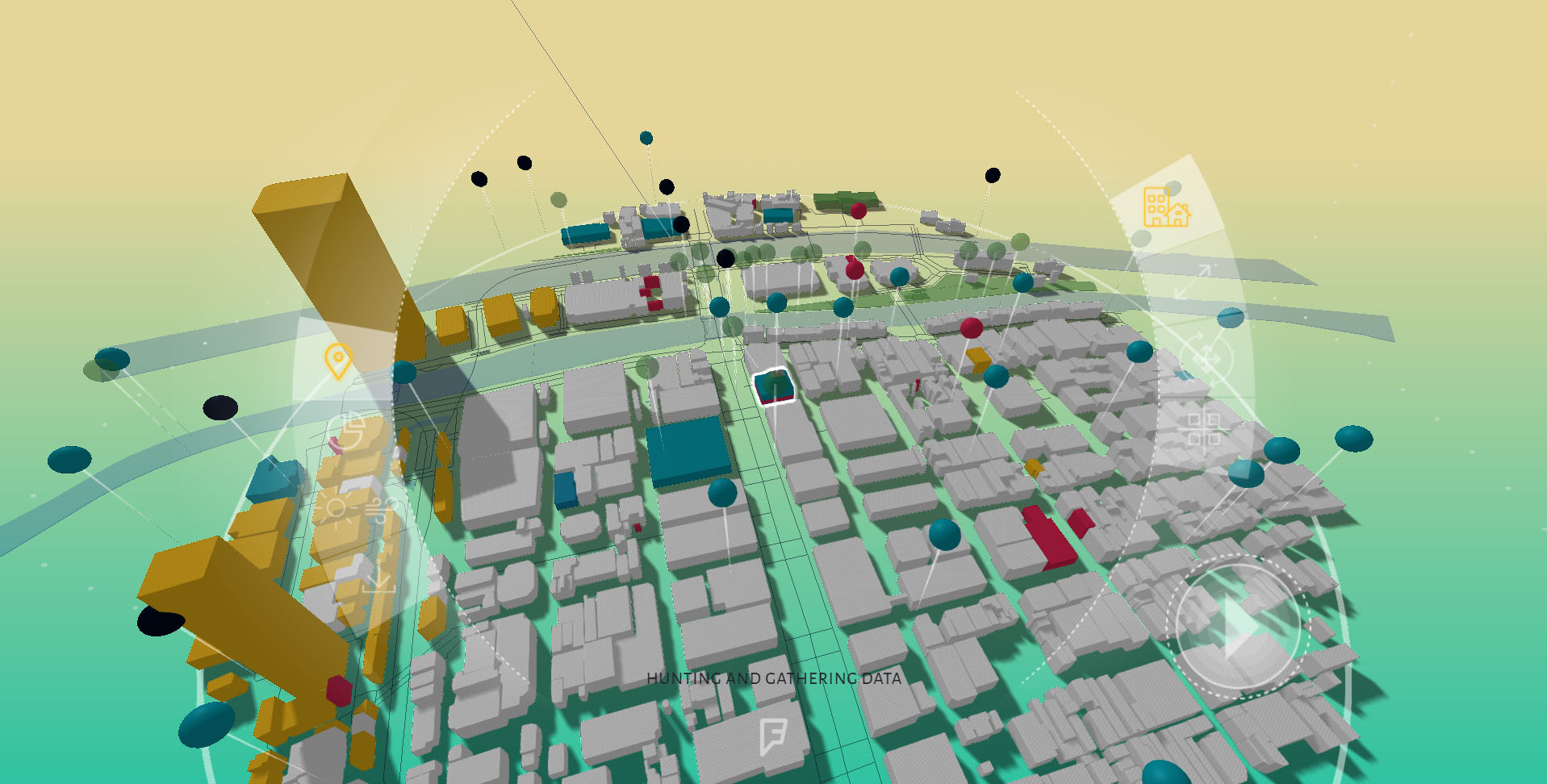How do designers and project developers confront some of the major environmental challenges that come as a byproduct of rapid development? Understanding climate change, population migration to cities and other environmental impacts will inform the future of urban design – but that information can be difficult to access.
A company that has these challenges front of mind is Digital Blue Foam. The Singapore-based company leverages a broad array of existing datasets to inform high-rise design. Their hope is that easy access to additional data will enable faster, greener, and more profitable architectural workflows. Current firms often do not take advantage of the wealth of environmental and contextual information that is available. This is, in part, due to the fact that the data is hosted by many different organizations and government agencies, making it time-consuming to gather and requiring multiple logins and accounts to access.
As a web-based tool, Digital Blue Foam analyzes information from multiple APIs, such as OpenStreetMap, or Foursquare, and collects city data, including GIS, climate, property, costing, energy, regulations, solar hatching, precipitation, solar irradiation, wind, pollution, and other information which affect sustainability. Using the collected data and artificial intelligence, designers can quickly generate and visualize high-quality massing options in seconds, which cater to local needs and demands.
“As an industry, we need to leverage all innovations to rethink what we are doing at all stages of the building process: from design methods, materials, and labour to avert this potential catastrophe.” -Camiel Weijenberg, co-founder of Digital Blue Foam
For designers, architects, and developers, Digital Blue Foam asserts that its software will save considerable time and lead to superior results in the early stages of the design process. The company claims it reduces the time for design study up to 98%.
The software features a minimal user interface with intuitive controls to help designers spend more time on design rather than crunching numbers, and also to help them communicate the benefits of their design to their clients. Digital Blue Foam also allows design teams to stream the generated building data directly to BIM software, such as Archicad. It also allows them to import an urban context, slabs, facade and other elements as native BIM elements.

A user interacts with Digital Blue Foam’s AI system by sketching on top of a building site on an online map in a back-and-forth process. As the designer draws, the AI interprets the sketches as input for generating designs based on different criteria. In this example, the designer sketches key axis and green zones, around which a district is planned and adapted computationally.
AEC Next caught up with Digital Blue Foam co-founders Sayjel Patel and Camiel Weijenberg to talk about their progressive approach to using data in design.
Can you briefly walk us through the history of Digital Blue Foam’s founding?
Patel: “The idea for Digital Blue Foam started from discussions Camiel and I had in January 2017. At that time we were both teaching part-time at Singapore University of Technology and Design. We became friends through our common interest to address many of the fundamental problems in the practice of architecture. In particular, how to accelerate the practice of sustainable building in emerging markets, as well how to address inefficiencies of everyday architectural practice. There was a clear synergy between us despite coming from different perspectives: I come from MIT and have a more academic approach, while Camiel, who was leading a design practice, had already cut his teeth as an entrepreneur and was looking for new ways to rethink the practice of design.”
Before Digital Blue Foam, what was missing in the design world?

Camiel Weijenberg, CEO of Digital Blue Foam
Weijenberg: “According to a recent study by the consulting firm McKinsey, the building construction industry is one of the least digitized fields. Beyond efficiency, this has contributed to the slow adoption of more sustainable buildings.
From our research, the benefit of digital design methods for quickly producing design options and step-up project efficiency is well understood by architects. However, more fundamental modes of design such as drawing and foam model-making are often more trusted and provide intangible value to the design process. Currently, there are few solutions on the market which seek to reconcile both sides of the design process.
With Digital Blue Foam, we see an opportunity to combine both; To introduce a new set of design tools which combine the world of analog sketching and model making with the world computational design and AI.”
How do you get the data that you incorporate into the tool – do you have partnerships with the dataset providers? Will you be adding additional datasets?
Weijenberg: “We are currently focusing on developing enterprise solutions built on our technology for major players in the AEC industry. We are gathering data from the web using open-source and well as paid datasets such as Open Street Maps and Google APIs. What we are also seeing is that our customers have access to historical project data which we are happy to integrate. This way, we can better estimate factors such as cost and energy use.”
How does having ready access to additional environmental data affect the design process?
Weijenberg: “Through many years of academic research, we explored how access to design data such as solar exposure, wind, and topography will have a drastic effect on the performance of a building or projects. Using computational methods, this information can be used to inform passive strategies regarding building shape, orientation, and envelope selection. This data can be used to explore the installation of elements such as building integrated Photovoltaics PV and rainwater collection.
Digital Blue Foam allows designers to access this data from Web APIs, which can be brought downstream throughout the design process. The data can also be used to quantify the benefits of sustainability to the users’ clients during the first meeting.”
Can you walk me through a typical workflow in using Digital Blue Foam software? At what part of the process would it be most useful?

Prof. Sayjel V. Patel, CTO of Digital Blue Foam
Patel: “The latest version of our technology allows a designer to use a tablet and pen to collaborate in real time with a computational design system which uses AI. In this new workflow, the designer interacts with an AI system by sketching on top of a building site on an online map in a back-and-forth process. As the designer draws, the AI interprets the sketches as input for generating design. The designer observes what the AI has produced, and can sketch over top to edit the result. This process can be repeated many times. When the user is satisfied with the designs, the website can sync the design to a Desktop BIM software, where it can be further refined.”
How do you see this software changing a building’s construction and life cycle?
Patel: “For our customers, this tool is useful in the early stages of the design process. Digital Blue Foam helps our clients to make decisions. For example, it can help them answer questions like what to build or even if a land parcel should be purchased. Because it is online, Digital Blue Foam can be used during design meetings where many possible options can be created and discussed within seconds. Digital Blue Foam can be used to educate clients who are not literate in architectural drawings about the merits or drawbacks of a project before substantial investments are made.
The reason we are targeting the initial design stage is because early-design decisions have a huge impact on the cost, sustainability and livability of the project. This saves users of Digital Blue Foam time, effort and money while creating better designs.”
How will Digital Blue Foam help move the construction industry to more sustainable and carbon negative practices?
Patel: “Our main goal is to make sure the discussion about sustainability and social responsibility happens from Day One in every project. Digital Blue Foam helps designers better educate their clients by quantifying design performance in a real-time design process.”
Why is it so important to address the environmental impacts of construction?
Weijenberg: “According to a United Nations Environment Programme 2018 report, buildings construction and operations accounted for 36% of global final energy use and nearly 40% of energy‐related carbon dioxide (CO2) emissions in 2017. As an industry, we need to leverage all innovations to rethink what we are doing at all stages of the building process: from design methods, materials, and labour to avert this potential catastrophe.”
Who are you envisioning as the target users of this platform?
Weijenberg: “We are developing enterprise solutions and targeting large AEC firms as the initial users of Digital Blue Foam. We aim to release a mass market version, which targets smaller architecture firms and land agents by Q4 2020.”
What are you most excited for in the future?
Weijenberg: “To be part of a growing global movement to redefine the future practice of architecture and building. So far, we have received a wide range of enquiries for virtually every project type: from bungalows, mixed-use high-rise, social housing development projects, and entire city districts. It has been a lot of fun speaking with and meeting architects and developers from all over the world and get their input into what we are doing.”
What are the goals of Digital Blue Foam for the AEC industry?
Patel: “The goal of Digital Blue Foam is to develop tools which help the AEC industry balance the demands of clients who try to maximize the value of land, and the ethical practice of sustainability, which is connected to minimize the impacts of CO2 on the built environment. We try to make this process efficient, and work in a way that is seamless, automatic and even fun; shifting the job of the architect from number cruncher, to finding solutions through design quality and exploration.
We are currently piloting our software on different project types and locations to better understand its potential applications. We are happy to connect with anyone who shares our vision for the future to see if there is a way we can work together.”






